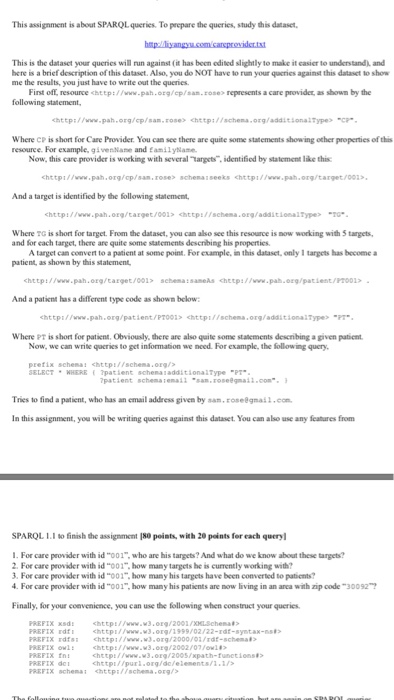Please answer 1-4 and explain.

This assignment is about SPARL queries. To prepare the queries, study this dataset, http;:..liyangyu.com/careprovider.txt This is the dataset your queries will run against (it has been edited slightly to make it easier to understand), and here is a brief description of this dataset. Also, you do NOT have to run your queries against this dataset to show me the results, you just have to write out the queries. First off, resource
represents a care provider, as shown by the following statement, "CP", Where CP is short for Care Provider You can see there are quite some statements showing other properties of this resource, For example, givenName and familyName, Now, this care provider is working with several "targets", identified by statement like this: schema:seeks , And a target is identified by the following statement, schema:sameAs And a patient has a different type code as shown below: "PT" Where PT is short patient, Obviously, there are also quite some statements describing a given patient. Now, we can write queries to get information we need. For example, the following query. Prefix schema: SELECT: WHERE (patient schema: additional Type "PT", ?patient schema; email "sam, rose@gmail.com", ) Tries to find a patient, who has an email address given by sam.rose@gmail.com. In this assignment, you will be writing queries against this dataset. You can also use any features from For care provider with id "001", , who are his targets? And what do we know about these targets? For care provider with id "001", , how many targets he is currently working with? For care provider with id "001", , how many his targets have been converted to patients? For care provider with id "001", , how many his patients are now living in an area with zip code"30092"? Finally, for your convenience, you can use the following when construct your queries, PREFIX xsd: PREFIX rdf: PREFIX rdfs: PREFIX owl: PREFIX fn: PREFIX dc: PREFIX schema: This assignment is about SPARL queries. To prepare the queries, study this dataset, http;:..liyangyu.com/careprovider.txt This is the dataset your queries will run against (it has been edited slightly to make it easier to understand), and here is a brief description of this dataset. Also, you do NOT have to run your queries against this dataset to show me the results, you just have to write out the queries. First off, resource represents a care provider, as shown by the following statement, "CP", Where CP is short for Care Provider You can see there are quite some statements showing other properties of this resource, For example, givenName and familyName, Now, this care provider is working with several "targets", identified by statement like this: schema:seeks , And a target is identified by the following statement, schema:sameAs And a patient has a different type code as shown below: "PT" Where PT is short patient, Obviously, there are also quite some statements describing a given patient. Now, we can write queries to get information we need. For example, the following query. Prefix schema: SELECT: WHERE (patient schema: additional Type "PT", ?patient schema; email "sam, rose@gmail.com", ) Tries to find a patient, who has an email address given by sam.rose@gmail.com. In this assignment, you will be writing queries against this dataset. You can also use any features from For care provider with id "001", , who are his targets? And what do we know about these targets? For care provider with id "001", , how many targets he is currently working with? For care provider with id "001", , how many his targets have been converted to patients? For care provider with id "001", , how many his patients are now living in an area with zip code"30092"? Finally, for your convenience, you can use the following when construct your queries, PREFIX xsd: PREFIX rdf: PREFIX rdfs: PREFIX owl: PREFIX fn: PREFIX dc: PREFIX schema:








